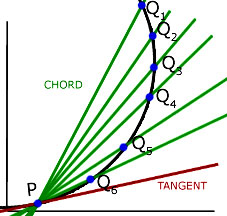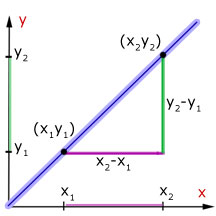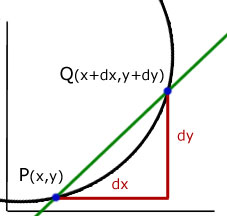First Principles

To find an expression for the gradient of the tangent at point P on a curve, we must consider lines passing through P and cutting the curve at points Q1 Q2 Q3 Q4 Q5 Q6 ...etc.
As Q approaches P so the gradient of the chord PQ approaches the gradient of the tangent at P.
We can form an expression for the gradient at P by using this concept.

We know from coordinate geometry that:

Consider the coordinates of P to be (x,y) and point Q to be(x+dx, y+dy), where dx and dy are the horizontal and vertical components of the line PQ.

Gradient of the line between points (x,y) and (x+dx, y+dy) is given by :
The tangent to the curve = gradient of PQ when the length of PQ is zero and dx = 0 and dy = 0.
in the limit, as dx 'approaches zero' the gradient of the curve is said to be dy/dx.
If we now replace y by f(x) in the expression for gradient, since y = f(x) i.e. y is a function of x.
and
y = f(x)
y + dy = f(x + dx)
we have:
that is,
Example: find the gradient of y = 4x2
cancelling by dx
in the limit when dx = 0 this becomes,
Without doubt this is a very long winded way to work out gradients. There is a simpler way, by using the Derivative Formula.
If y = 3x2 , which can also be expressed as f(x)= 3x2, then
the derivative of y with respect to x can be expressed as:

If we have a function of the type y = k x n , where k is a
constant, then,

example #1
Find the gradient to the curve y = 5 x2 at the point (2,1).
gradient = (5) (2 x2-1) = 10 x1 = 10 x
gradient at point (2,1) is 10 x 2 = 20
Differentiation Calculus Formulas:
1.  (x n ) = n xn-1
(x n ) = n xn-1
2.  (ln x) =
(ln x) = 
3.  (cos x) = −sin x
(cos x) = −sin x
4.  (ex) = ex
(ex) = ex
5.  (tan x) = sec2x
(tan x) = sec2x
6.  (sin x) = cos x
(sin x) = cos x
7.  (logb u) =
(logb u) = 

8. .
%7D) =
= 
9. 
%7D) =
=  +
+ 
Learning Differentiation Online Study Problems:
Learning differentiation online study Problem 1:
Solve the differentiation logarithmic function f(x) = ln(4x + 10) with respect to x.
Solution:
Let u = 4x + 10 So, f(x) = ln u
f(x) = ln u
= 

= %7D)
= 
Answer: Differentiation of ln(4x + 10) is 
Learning differentiation online study Problem 2:
Solve the differentiation of given function y = x3 - 7cot x.
Solution:
Let y = x3 - 7cot x
= 3x2  - 7
- 7 (cot x) (we know .
(cot x) (we know .  (cot x) = - cosec2x)
(cot x) = - cosec2x)
= 3x2 - 7(-cosec2x)
= 3x2 + 7cosec2x
Answer: Differentiation of x3 - 7cot x is 3x2 + 7cosec2x
Learning differentiation online study Problem 3:
Solve the differentiation of exponential function 10e4x
Solution:
Here, a = 4
So, = 10 e4x
e4x
= 10(4) e4x
= 40 e4x
Answer: Differentiation of 10e4x is 40 e4x
Differential Calculus Formulas
If you can't view the formulas correctly, then you need to download FireFox Web Browser.
- Sum Rule:
= f ′ ( x ) ± g ′ ( x ) - Product Rule:
= f ′ ( x ) · g ( x ) + f ( x ) · g ′ ( x ) - Quotient Rule:
= f ′ ( x ) · g ( x ) − f ( x ) · g ′ ( x ) g 2 ( x ) - Chain Rule:
= f ′ ( g ( x ) ) · g ′ ( x ) - Inverse Rule:
f − 1 ] ′ ( t ) = 1 f ′ ( f − 1 ( t ) )
Rules
-
d x c = 0 -
d x c f ( x ) = c d d x f ( x ) -
d x x n = n x n − 1 -
d x sin a x = a cos a x -
d x cos a x = − a sin a x -
d x tan x = sec 2 x -
d x cot x = − csc 2 x -
d x sec x = sec x tan x -
d x csc x = − csc x cot x -
d x e a x = a e x -
d x a x = ln ( a ) a x , a > 0 & a ≠ 1 -
d x ln x = 1 x -
d x log a ( x ) = 1 ln ( a ) x , a > 0 & a ≠ 1 -
d x arcsin x = 1 1 − x 2 -
d x arccos x = − 1 1 − x 2 -
d x arctan x = 1 1 + x 2
Reference Formulas:
Differential and Integral Calculus
1. Hyperbolic Functions

2. Convergence of Sequences and Series
2.1 Infinite sequences
Cauchy's convergence test
A sequence of numbers an is convergent if, and only if, there exists for every positive constant e a number N such that
Operating with limits
If  exist, then
exist, then

2.2 Infinite Series 8:
Cauchy's convergence test
The series San converges if, and only if, for there exists for every positive quantity e a number N such that
Note: All the following criteria are sufficient, but not necessary.
Principal of Comparison of Series 8.2 San converges if there exist numbers bn such that bn ³ |an| for all values of n and Sbn converges.
Ratio test and and root test
San converges if there is a number N, and also a number q < 1 such that

for all values n > N; in particular, if there is a number k < 1 such that

Leibnitz's Test
San converges if the terms have alternating signs and |an| tends monotonically to zero.
3. Differentiation
3.1 General rule (Fundamental Ideas:

Chain Rule


with corresponding formulae for uxy and uyy
Implicit Functions

Functions expressed in terms of a parameter

Inverse functions


3.2 Special Formulae

4. Integration
4.1 General Rules (Fundamental Ideas)


Estimation of Integrals

Integration by Parts

Method of Substitution

Link between Differentiation and Integration

Improper Integrals
If f(x) is continuous except at the point x = b, where it becomes infinite,  is (absolutely) convergent, if in the neighbourhood of x = b
is (absolutely) convergent, if in the neighbourhood of x = b

where n > 1, for values of x ³ A.

4.2 Special Formulae





Recurrence Relations

4.3 Integration of Special Functions
4.3.1 Rational functions
These are reduced to the following three fundamental types by resolution into partial fractions

the integral on the right hand side being evaluated by the last recurrence relation above;

where the integral on the right hand side is of the preceding type.
In the sequel, R denotes a rational function.

Substitution: t = tan x/2, so that

However, if R is an even function or only involves tan x, the following substitution is more convenient:


Substitution t = tanh x/2, so that


Substitution t = emx, dx/dt = 1/mt.

Substitution:


Substitution:


Substitution:


The substitution  reduces this integral to one of the preceding three types.
reduces this integral to one of the preceding three types.
 reduces this integral to one of the preceding three types.
reduces this integral to one of the preceding three types.
Substitution: 


Substitution:

5. Uniform Convergence and Interchange of Infinite operations
For the definition of uniform convergence go to
A series, which is uniformly convergent in a closed interval and the terms of which are continuous functions, represents a continuous function in the interval
If |f(x)| £ an and San converges, Sfn(x) converges uniformly ( and absolutely).
Interchange of summation and differentiation
Any convergent series of continuous functions may be differentiated term by term, provided the resulting series converges uniformly.
Interchange of summation and integration
Any uniformly convergent series of continuous functions may be integrated term by term. The resulting series also converges uniformly.
6. Special Links
Stirling's Formula

Wallis' Product

Infinite products



Definition of the Gamma function

if x is a positive integer n,
Order of magnitude of functions



7. Special Definite integrals
Orthogonality relations of the trigonometric functions



8. Mean Value theorem
Mean value theorem of the differential calculus

If f(x) = f(x + h) = 0, this yields Rolle's theorem : Between two zeros of the function lies always a zero of the derivative.
Generalized Mean Value theorem

where x is a value between a and b.
Taylor's theorem

with the remainder

Mean value theorem of the integral calculus

9. Expansion in Series: Taylor Series, Fourier Series
1. Power series Definition
9.1.1 Power series in general
Any power series

in one variable has a radius of convergence r (which may be zero or infinite); the series converges when |x| < r; in fact, it converges uniformly and absolutely in every interval |x| £h, where h < r; when |x| > r; the series diverges
If the remainder in Taylor's theorem tends to zero as n increases, we have the infinite power series

9.1.2 Special Taylor series

where the Bn are Bernoulli numbers A8.4.

9.1.3 Binomial series

9.1.4 Elliptic integral

9.2 Fourier series
If the function f(x) is sectionally smoot
h in the interval -p £ x £ p, i.e., if its first derivative is sectionally continuous, the Fourier series

is absolutely convergent throughout the entire interval. If f(x) has a finite number of jump discontinuities, while f '(x) is elsewhere sectionally continuous, the series converges uniformly in every closed subinterval which contains no discontinuities of f(x). At every point at which f(x) is continuous, the series represents the value of the function f(x), while at every point of discontinuity of f(x) it represents the arithmetic mean of the right hand and left hand limits of f(x).
10. Maxima and Minima
The following rule holds only for maxima and minima in the interior of the region under consideration.
In order that x may be an extreme value of the function y = f(x), f '(x) must vanish. When this condition is satisfied, there is a maximum or minimum, if the first non-vanishing derivative of f(x) is of even order; if it is of odd order, there is neither a maximum nor a minimum. In the former case, there is a maximum or a minimum according to whether the sign of the first non-zero derivative is negative or positive .
11. Curves
In what follows, x, h are current co-ordinates.
Equation of the curve:
Equation of the tangent at the point (x,y)

Equation of the normal at the point (x,y)

Curvature

Radius of curvature

Evolute (locus of centre of curvature)

Involute
where a is an arbitrary constant and s is the length of arc measured from a given point.
Point of inflection
Necessary condition for a point of inflection is

Angle between two curves

In particular, the curves are orthogonal, if
the curves touch, if
Two curves y = f(x), y = g(x) have contact of order n at a point x, if 6.4

12. Length of Arc, Area, Volume
Length of arc
Let a plane curve be given by the equations

The length of arc is

Area of plane surface
The area bounded by the curve
and two radius vectors q0, q1, where r, q are polar co-ordinates, is given by 5.2.4

The area, enclosed by the curve
the two ordinates x = x0, x = x1 and the x-axis, is 2.1.2

Volume
The volume lying over a region R and bounded above by the surface with the equation
is given by 10.6


No comments:
Post a Comment